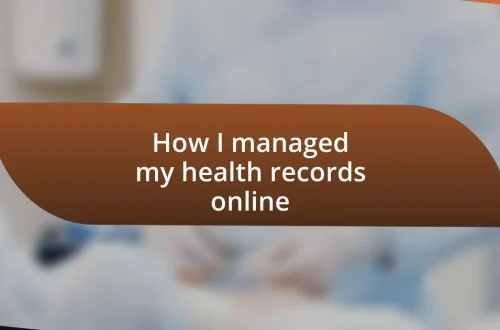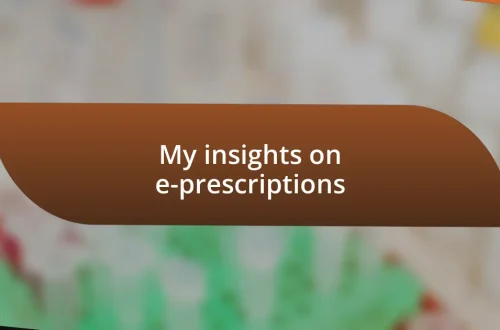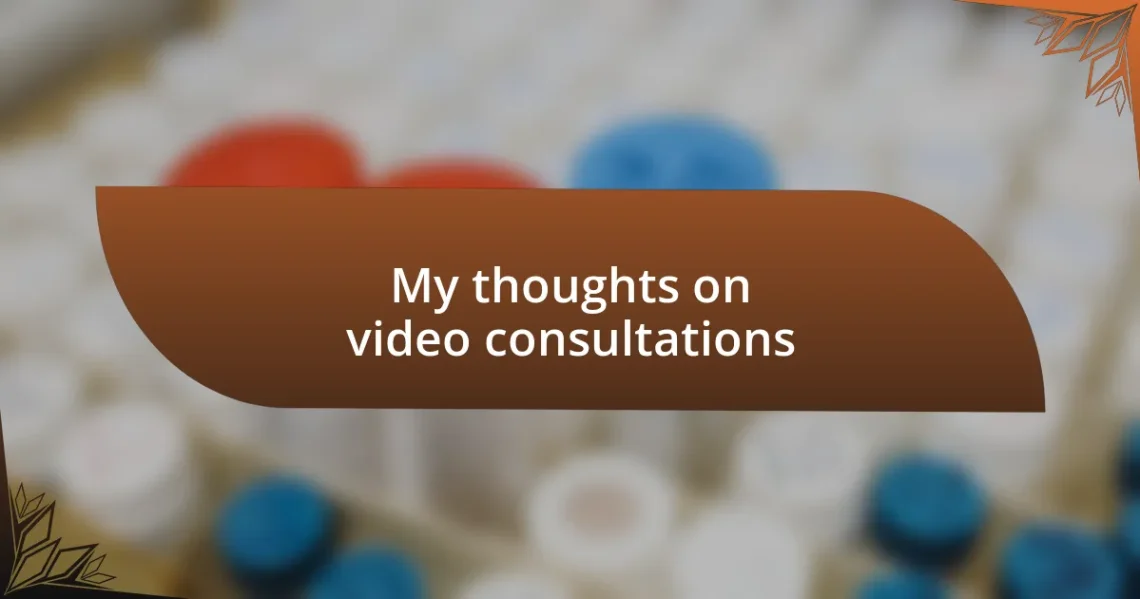
My thoughts on video consultations
Key takeaways:
- Video consultations enhance accessibility to healthcare, particularly for those in remote areas, offering convenience and timely care.
- Challenges include technology barriers, difficulty in building rapport, and privacy concerns, which can hinder effective communication.
- Best practices for video consultations emphasize a well-lit environment, technology testing, and maintaining eye contact for better engagement.
- The future of video consultations may involve AI integration for improved scheduling and enhanced security features to protect sensitive information.
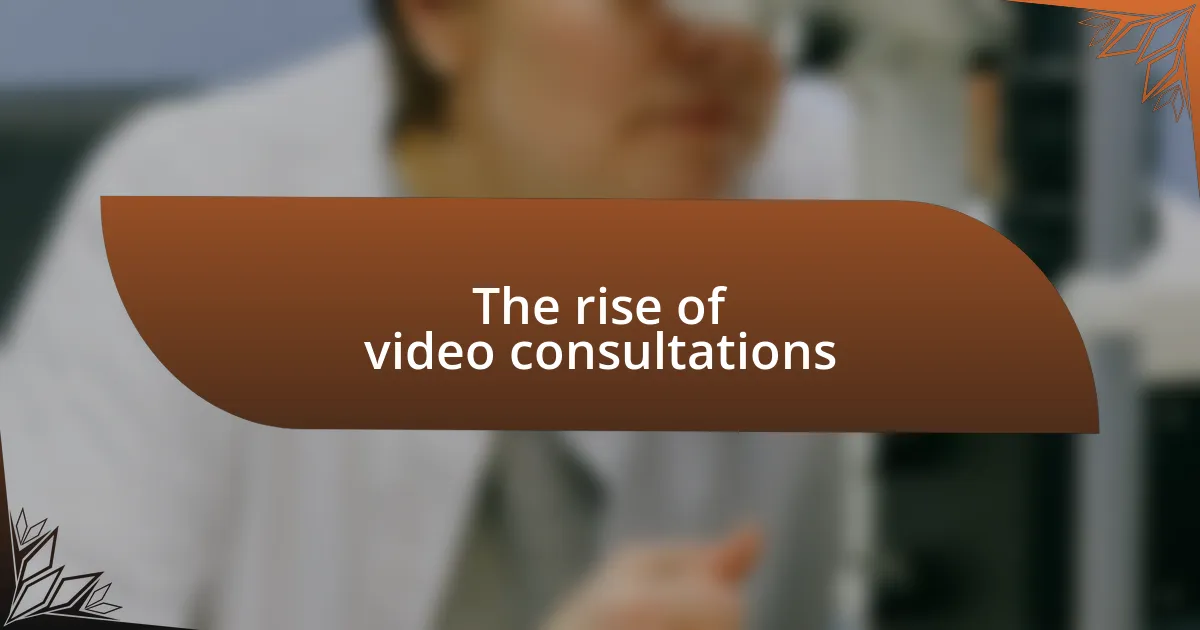
The rise of video consultations
Video consultations have witnessed a remarkable surge, especially in recent years. I remember my initial hesitation about discussing health issues with a doctor on a screen instead of in person. Would it feel as personal? But experiencing it firsthand shattered my doubts; the convenience and comfort of being in my own space made the consultation feel surprisingly intimate.
With this rise, I often reflect on how video consultations have broadened access to healthcare. Have you ever considered the struggle of someone living in a remote area, far from the nearest clinic? Just think about it: they can now connect with specialists without the long, often exhausting trips. It’s a game changer in providing timely care that otherwise might have been delayed.
Moreover, the evolution of technology plays a pivotal role in this trend. As I dig deeper into the advancements in video communication tools, I can’t help but feel optimistic. These innovations not only enhance the quality of interaction but also empower both patients and providers to engage in meaningful dialogues about health management in real time. Isn’t it exciting to think about where this technology could take us next?
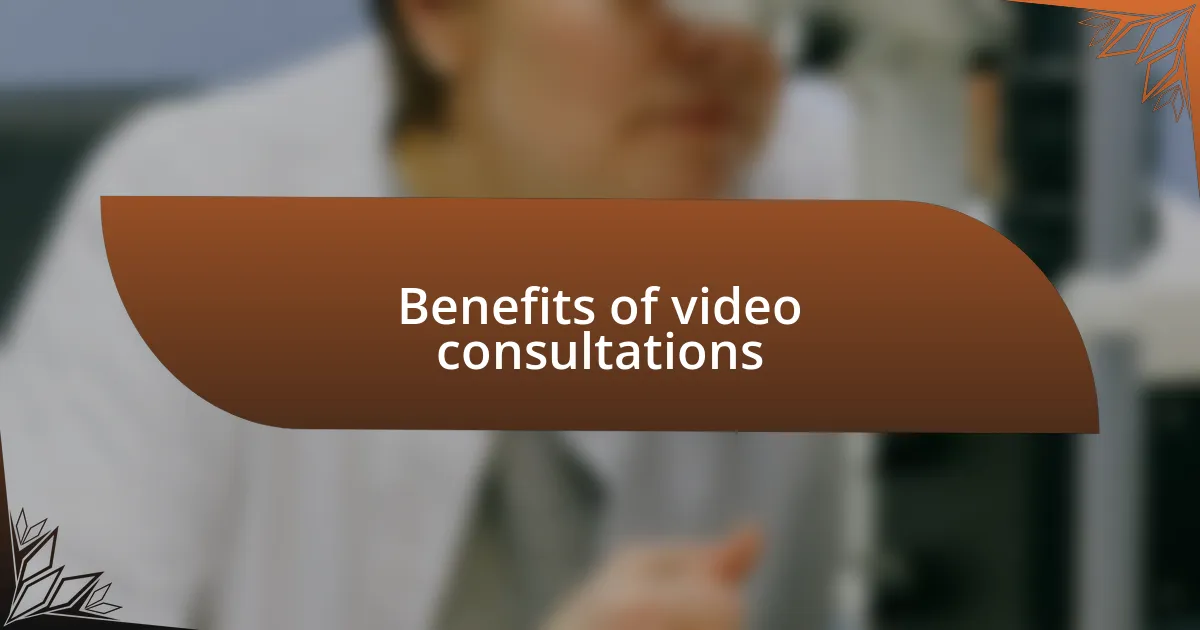
Benefits of video consultations
Video consultations offer numerous advantages that transform the healthcare experience. One of the most compelling benefits I’ve experienced is the flexibility they provide. Imagine having a medical appointment scheduled during your lunch break or right from the comfort of your couch. It’s a luxury that traditional in-person appointments simply can’t match.
- Accessibility for those in remote areas
- Reduced travel time and associated costs
- Increased convenience for those with mobility challenges
- The ability to involve family members in consultations easily, regardless of location
Another aspect I truly appreciate is the time efficiency. I recall a particular visit where I could see my doctor for a quick follow-up without the typical waiting room hours. This efficiency means I can focus more on my everyday tasks while still managing my health effectively. Video consultations help eliminate the stress of traditional appointments, making healthcare feel more approachable and less daunting.
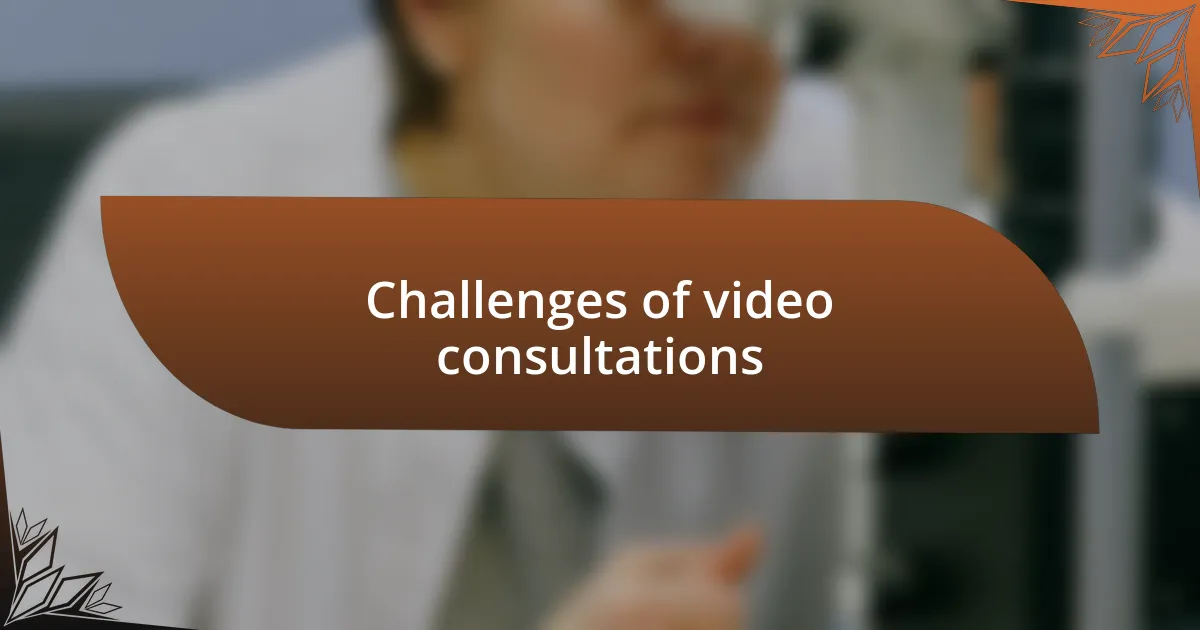
Challenges of video consultations
Video consultations, while innovative, come with their own set of challenges. One significant hurdle I’ve encountered is the technology barrier. Not everyone has access to high-speed internet or devices that support video calls. I remember once assisting a friend who struggled to connect for an important appointment. It highlighted how easily access to care can falter due to technological limitations, leaving patients frustrated and missing vital health information.
Another challenge I’ve observed is the difficulty in establishing rapport. It’s undeniably different to communicate through a screen compared to face-to-face interactions. I often feel that subtle non-verbal cues, like body language and eye contact, play a critical role in patient-doctor relationships. There’s something about being in the same physical space that creates a layer of comfort and trust, which can sometimes be lost in video format.
Privacy concerns also loom large over video consultations. I understand how people might feel uneasy discussing sensitive issues without guaranteed confidentiality, especially if they’re in a less private space. There was a time I found myself in a crowded café during a consultation, and I couldn’t help but feel anxious about being overheard. It made me realize how crucial a controlled and secure environment is during these healthcare discussions.
| Challenge | Details |
|---|---|
| Technology Barrier | Access to high-speed internet and suitable devices is not universal. |
| Rapport Building | Establishing trust is harder without in-person interactions. |
| Privacy Concerns | Patients may worry about confidentiality in their surroundings. |
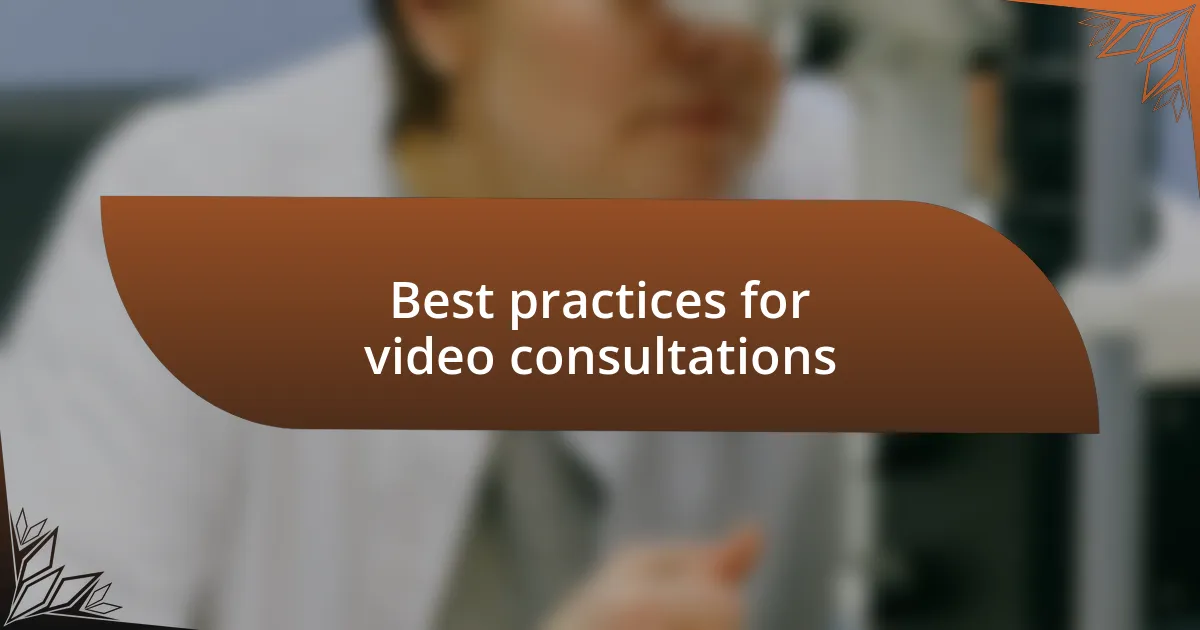
Best practices for video consultations
To make the most of video consultations, it’s essential to prioritize a well-lit and quiet environment. I often find that when the lighting is poor, it can create an awkward disconnect. Have you ever noticed how hard it is to focus on someone’s words when shadows obscure their face? Ensuring a bright, clear view not only enhances communication but also conveys professionalism.
Another key practice is to test the technology beforehand. I’ve learned this the hard way. There was a time when I joined a video call only to discover my microphone wasn’t working. Picture the awkward moments of silence as I frantically fiddled with my settings while everyone else waited. It’s a reminder that a little preparation can go a long way in fostering smooth interactions and reducing anxiety.
Lastly, maintaining eye contact by looking directly at the camera can significantly improve engagement. In my experience, when I focus on the camera, it feels more personal, almost like I’m truly connecting with the person on the other side. Have you ever felt more involved in a conversation when there’s that genuine eye contact, even through a screen? These small adjustments can transform the quality of the consultation, making both the patient and provider feel more present.
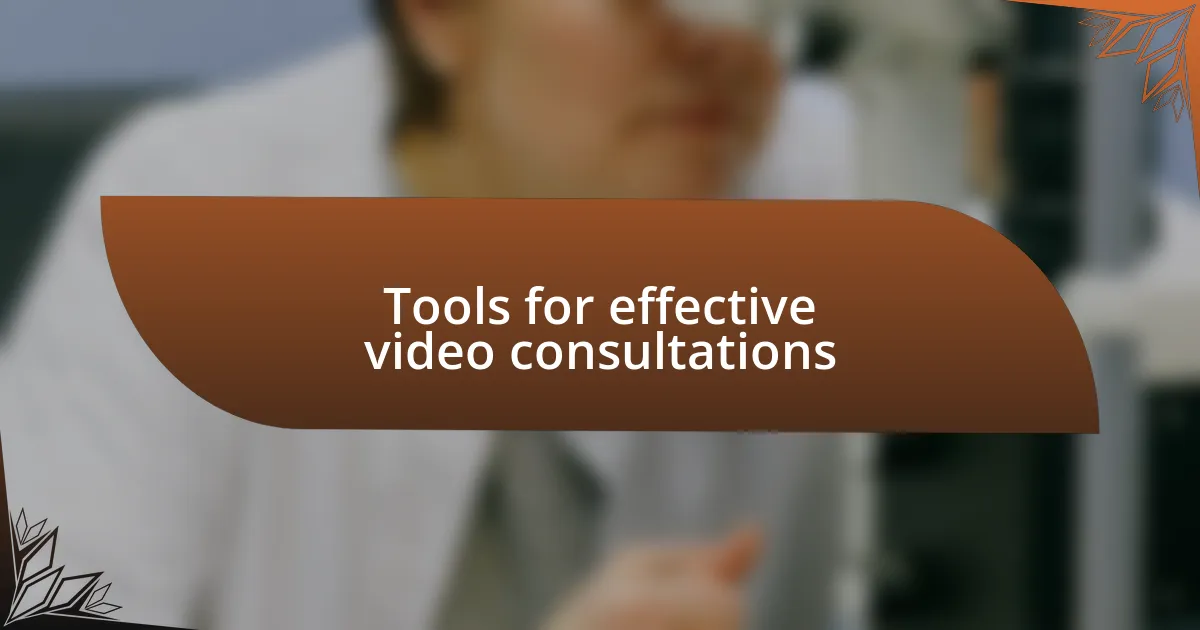
Tools for effective video consultations
When it comes to tools for effective video consultations, reliable software is paramount. I’ve experimented with various platforms, and I’ve found that user-friendly interfaces like Zoom or Microsoft Teams reduce the technical barriers, allowing for a smoother experience. Have you ever joined a call and spent the first ten minutes just navigating the system? It can be frustrating and detracts from the purpose of the meeting.
Another essential tool is a good-quality webcam and microphone. Recently, I upgraded to a high-definition webcam, and it dramatically improved my clients’ ability to see my expressions and gestures, fostering a more personal connection. I can’t stress enough how audio quality makes a difference; a clear and crisp sound keeps the conversation flowing without the need for constant repetition. Have you ever tried to listen to someone speaking through a muffled microphone? It’s exhausting.
Don’t overlook the importance of having a stable internet connection. I recall a particularly important consultation that was interrupted by sporadic disconnections; nothing sours the mood more than a freezing screen in the middle of a crucial discussion. Investing in a stronger internet plan can save you from those frustrating moments. What’s worse than trying to communicate important information while worrying about technical glitches? It’s worth considering every piece of technology that contributes to communication clarity.
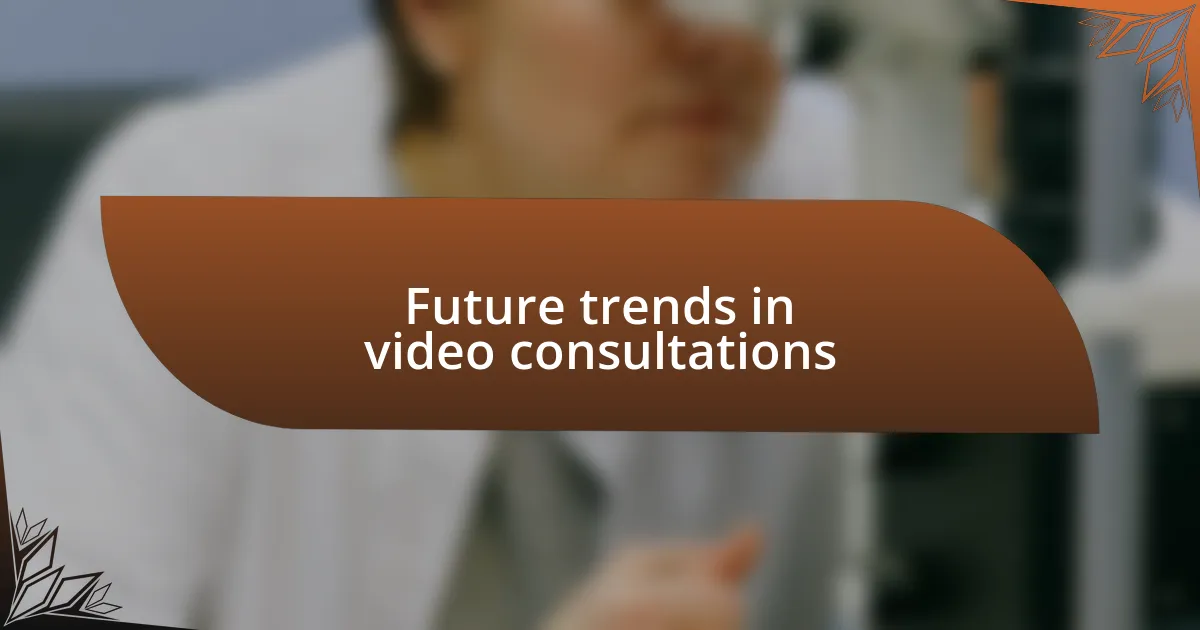
Future trends in video consultations
As I think about the future of video consultations, I can’t help but feel excited about the potential integration of artificial intelligence (AI). In my experience, AI can help streamline scheduling and even assist with real-time transcription. I remember using a tool that summarized our conversation afterward, and it was a game-changer—I could focus on the discussion instead of jotting down notes.
Moreover, we’re likely to see enhanced security features becoming more prevalent. Cybersecurity has always been a concern, but it’s becoming crucial as more sensitive information is discussed online. I recently had to reassure a client about the confidentiality of our virtual sessions, and knowing that robust encryption is on the horizon gives me peace of mind. It’s reassuring to know that as we adopt these technologies, our conversations will remain private and secure.
Finally, I believe that virtual reality (VR) will soon play a significant role in enriching the video consultation experience. Imagine stepping into a virtual room with your client—how much more immersive would that be? Having experienced a VR meeting once, I was amazed at how presence could enhance connection, making discussions feel more genuine. As technology evolves, the emotional nuances of communication will likely improve, allowing for deeper interactions that mimic face-to-face meetings.
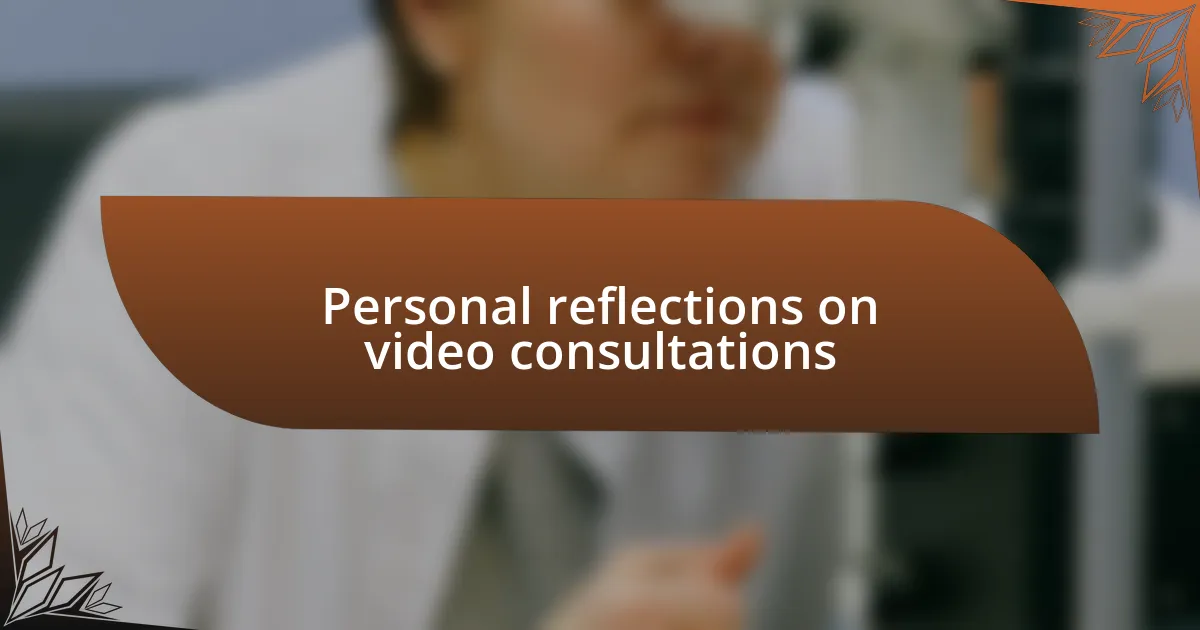
Personal reflections on video consultations
There are moments during video consultations when I find myself reminiscing about face-to-face interactions. I remember the comfort of sharing a cup of coffee with a client; it made the conversation feel more personal. Now, I find myself wondering—can a screen really recreate that warmth? Sometimes, despite the technology, I still miss that physical connection.
In my experience, video consultations can blur the lines of professionalism and informality. There have been times when I’ve seen a client in their home environment, and it added a layer of authenticity to our discussions. It’s fascinating how the backdrop of someone’s living space can tell a story that complements their words. Has anyone else felt that same intimacy through a screen?
However, I acknowledge the unique challenges that video calls bring, like distractions from our surroundings or the occasional tech hiccup. I once had a session interrupted by a barking dog, which made us both laugh and lightened the mood. It’s moments like these that remind me to embrace the unpredictability. How do we adapt to these interruptions? For me, it’s about staying flexible and finding joy in the imperfections of virtual interactions.


